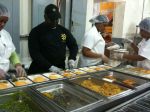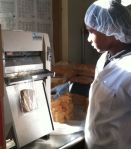Given the low rates that public institutions–such as schools, elder care facilities, and child care centers–are able to pay, is it possible to produce institutional meals that taste good and are good for you? City Fresh Foods founder Glynn Lloyd boldly states that “Bottom line – it doesn’t have to be crap.”
The market for government-subsidized prepared meals tends to be dominated by the big companies like Sodexo and Aramark that produce most of the institutional food served at universities, hospitals, military bases, and the like. While the big guys are changing some of their practices to use local suppliers and provide healthier foods, these corporations are not going to make fundamental changes to our current food system.
The Sustainable Business Network of Greater Boston recently sponsored a tour of the City Fresh building, which is tucked away in an industrial corner of Roxbury in the former Dancing Deer Bakery factory. The company prepares 8,000 meals a day, primarily for the “public market”–-publicly-subsidized meals at schools, child care centers, elder care facilities, and other institutions. It’s a highly capitalized, labor-intensive, low-margin business– a far cry from the tiny inner-city catering business that Glynn Lloyd started in 1994. Today, City Fresh employs 75 people, and 95 percent of them are from the neighborhood.
“We have to provide a good service,” Glynn Lloyd says, “because our staffers have kids in schools who get our meals. Even my grandmother was getting City Fresh meals.”
While Lloyd confesses that their meals are still far from where they want them to be, City Fresh is trying to make the food as healthy as possible. Diabetes and obesity are rampant in communities of color. “Our kids are dying,” Glynn Lloyd says. “We need to push the envelope.”
While many of the challenges are financial—how do you deliver a prepared, hot meal for well under $2.00 a person?—there are also more practical issues, like chicken bones, to chew over. City Fresh tried to serve children fresh chicken, instead of the high-fat, processed chicken nuggets served at most schools, but the children only get 15 minutes to eat. “Our kids can’t cut the chicken,” the school administrators said, so City Fresh had to resort to the dreaded chicken nuggets. The City Fresh version is made from whole breast chicken meat, but they are still battered and flash fried.
City Fresh buys from as many local vendors as possible, which helps keep money circulating in the community. They get their bread from a local bakery and grass-fed beef from a farmer within 100 miles of their facility every two weeks. They also buy local produce from their sister company, City Growers, which is trying to turn vacant urban land into sustainable farms.
While I was impressed by City Fresh’s efforts to create tasty, healthy meals on the shoestring budget that our society has allocated for publicly supported institutional meals, what I took away from the tour was that this is a social problem that no one company can solve. Maybe, just maybe, if we tried subsidizing local food systems instead of industrial agriculture, we could all eat better food.




Love the photos! I was behind a City Fresh Foods truck last night and wondered exactly how they fit in to the local healthier-eating scene! Now I know.